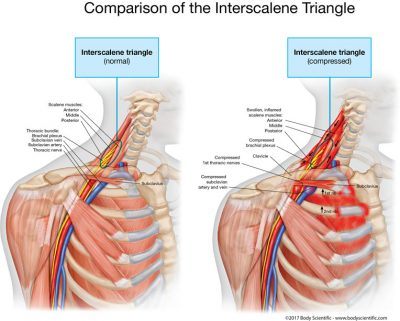Table of Contents
Preface
Introduction
The Sonny Burke Story
Chapter I What is Thoracic Outlet Syndrome? (TOS)
Chapter II Anatomy
Chapter III The TOS Controversy
Chapter IV History, Cause, and Patient Presentations
Chapter V Physical Examination Findings
Chapter VI Diagnostic Tests
Chapter VII Standard of Care Approaches – Surgical and Non-Surgical
Chapter VIII Frequently Asked Questions
Chapter IX Case Histories of Patients
Chapter X The Human Spring Approach to Treatment and Prevention
Chapter I
What is thoracic outlet syndrome?
Thoracic Outlet Syndrome (TOS) occurs when the nerves, veins and arteries that pass through the thoracic outlet become compressed. The thoracic outlet is the space between your collarbone (clavicle) and your first rib. This narrow passageway is crowded with blood vessels, nerves and muscles. (For more information from mayo clinic and the picture above, click here)
Some patients have severe pain at the neck, stiff neck, repeated migraines, shoulder pain, neck and should pain (feels like (Polymyalgia rheumatica) and a sense of muscle tiredness or heaviness in the arm caused by thoracic outlet syndrome. Other symptoms of thoracic outlet syndrome may include tenderness over the neck muscles or around the collarbone, pressure on these areas causing pain or tingling in the arm, pain in the shoulder or arm with neck movements, and tenderness in the armpit. Even odd sensations in the face or ringing in the ear or ear pain can be caused by thoracic outlet syndrome. The nerves supply sensation and muscle power to the arms and the arteries and veins as well as the nerves on the neck, provide blood supply to the arm. The pressure against these structures is caused by tight swollen scalene muscles, in the neck, shoulder and chest muscles as well as an elevated first rib with a depressed collarbone. Nerve entrapment or nerve compression can occur because there are many areas for these arteries and nerves to get compressed.
That is why it’s important for you to understand the thoracic outlet anatomy so you can differentiate between venous thoracic outlet, arterial thoracic outlet syndrome, (vascular thoracic outlet), cervical ribs thoracic outlet syndrome, Polymyalgia rheumatica, thoracic outlet brachial plexus compression (neurogenic thoracic outlet), carpal tunnel syndrome, pectoralis minor thoracic outlet syndrome or maybe you have all of the above! Thoracic outlet syndrome is a very controversial subject. In fact a lot of doctors don’t think it exists. Thoracic outlet syndrome is the most difficult neurovascular compression syndrome of the extremities to manage and that is because it has a variability of complaints. It also has a difficulty in the patient compliance in the treatment and reduction of the causative factors.
History of Thoracic Outlet Syndrome
First of all, this problem is not a new problem. Galen who made the first mention of the cervical rib first mentioned it in the 2nd century AD. In 1910 Murphy gave mention of the effectiveness of the first rib resection. In 1927, Adson brought up the scalenectomy without cervical rib resection. In 1956 Deete coined the term Thoracic Outlet Syndrome.
READ MORE POSTS ON THORACIC OUTLET SYNDROM
www.thoracicoutletsyndrome.com









